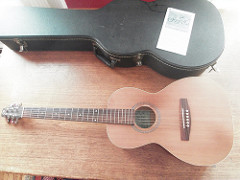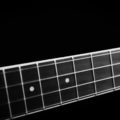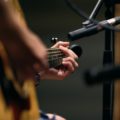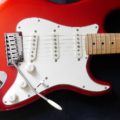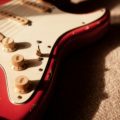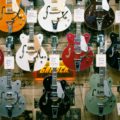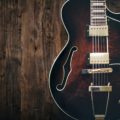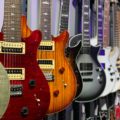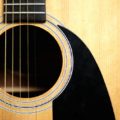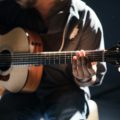Benefits and Disadvantages
Fretless bass guitar Learning to Enjoy Bass Guitar - Do you enjoy bass guitar? A bass guitar is a four-stringed instrument that typically accompanies a lead guitar. Some bass guitars have additional strings, with 5 or 6 strings in total. Bass guitars produce lower tones, and an electric bass guitar is connected to an amplifier for enhanced sound. When learning to play the bass…
Fretless guitars offer several benefits and disadvantages compared to their fretted counterparts. One of the advantages is that fretless guitars are not limited to specific musical tunings, tuning systems, or temperaments, unlike fretted instruments. This allows for playing music in scales that contain more than 12 tones, which are often found in non-Western or experimental music. Additionally, fretless guitars produce a unique sound because the soft fingertip absorbs the string’s vibration more quickly than a fret, resulting in a more dampened pizzicato sound. Players can even use their nails to finger the notes, similar to Indian sarod players, which can help maintain and brighten the sound.
However, playing a fretless instrument requires more training for the fretting hand to accurately position and shift notes. Ear training is also essential to discern the subtle variations in intonation that fretless instruments allow. To aid in this, many fretless guitars and basses have lines or markers indicating half-tone increments.
Acoustic fretless guitars generally produce less volume than their fretted counterparts, but this can be addressed by using pickups and amplification. Fretless bass guitars, which have heavier strings and larger bodies, are typically amplified to achieve sufficient volume.
Fretless instruments
Fretless guitars are often modified versions of factory-made “fretted” guitars, with the frets being removed by the player or a specialist luthier. There are also expert builders who specialize in crafting custom-made fretless guitars.
Fretless bass guitars are more common than fretless guitars, and many manufacturers offer them as standard models.
Famous users
Here is a list of famous users of fretless guitars and basses, in no particular order:
Fretless guitar:
- John Cale used a fretless guitar on the 1965 album “Stainless Steel Gamelan.”
- Erkan Our, a Turkish pioneer of the fretless guitar, primarily plays self-made fretless guitars.
- Frank Zappa used fretless guitars on a few albums in the early and mid-1970s.
- David Fiuczynski extensively plays fretless guitar in his instrumental project KiF.
- Ron Thal (Bumblefoot) has utilized fretless guitars extensively.
- Adrian Belew used fretless guitars on some recordings in the 1980s.
- Franck Vigroux played fretless guitar on Push the Triangle’s album “repush” and live performances.
- Michael Atonal Vick (VVV) founded the NYC Fretless Guitar Festival and has been playing fretless guitars since the early 1990s.
- Steve Vai played a triple-neck guitar (12 string, 6 string, and 6 string fretless) during live shows in the past.
- Elliott Sharp has occasionally used fretless guitars, including on his 1996 album “Sferics.”
- Karl Sanders plays fretless guitars with Nile and as a solo artist.
- Si Hayden plays a custom semi-fretless model with Joe O’Donnell (Celtic rock violinist) and extensively on the jazz/poetry album “Backra Men” (Morley Hayden Haines). He also played on his solo guitar album “The Obvious Rules of Thumb.”
- Ned Evett is a glass fretless guitarist who has opened for Joe Satriani on many tours.
- Brian Larkin, Tim Donahue, Talradin Dobavich.
Fretless bass
Fretless bass guitars offer various benefits and disadvantages compared to their fretted counterparts. One of the advantages is the unique tonal quality they provide. Fretless basses produce a smooth and warm sound due to the absence of frets, allowing for subtle nuances in pitch and expression. This characteristic makes them suitable for playing melodic lines and creating expressive solos.
Additionally, fretless bass guitars allow for greater flexibility in intonation. Players can slide between notes smoothly and achieve microtonal variations, expanding their melodic and harmonic possibilities. This is particularly advantageous in genres such as jazz, fusion, and world music, where complex tonalities and improvisation are prominent.
However, playing a fretless bass requires more precision and technique compared to a fretted bass. Without frets as reference points, players must rely on their ear and muscle memory to accurately find and maintain the correct pitch. This demands a higher level of finger placement accuracy and a well-developed sense of intonation.
Another consideration is the potential for increased string wear on a fretless bass. Since the strings come into direct contact with the fingerboard, they can cause more friction and wear over time. To mitigate this, some players use specific string types, such as flat-wound or nylon tape-wound strings, which are gentler on the fingerboard.
Famous users
Here is a list of notable musicians who have used fretless bass guitars, presented in no particular order:
- Jaco Pastorius (bassist for Weather Report) is widely regarded as one of the most influential fretless bass players of all time. He extensively used a customized fretless Fender Jazz Bass that he modified himself.
- Juan Alderete (bassist for The Mars Volta and Racer X) frequently incorporates fretless basses in his musical career, including a custom fretless Fender Jazz Bass as his primary instrument on the album “Frances the Mute.”
- Bill Wyman (former bassist of The Rolling Stones) was one of the first bass players to utilize a fretless bass, which can be heard on many early Rolling Stones records.
- Rick Danko (of The Band) played a fretless bass for many years, starting from the recording of the album “Music From Big Pink.”
- Freebo (session musician known for his work with Bonnie Raitt) has employed a fretless bass extensively in live performances and recordings.
- Brent Liles (bassist for Social Distortion and Agent Orange).
- Jonas Hellborg (solo bassist) extensively used fretless bass guitars in his solo recordings and collaborations. He currently has a signature bass co-designed by him from Warwick.
- Pedro Aznar, bassist and composer known for his work with Ser Girn and The Pat Metheny Group.
- Laurence Cottle, a British session bassist, has worked with a diverse range of artists such as Sting, Cher, Brian Eno, Eric Clapton, and Black Sabbath. He is proficient on both fretless and fretted bass guitars.
- Steve Bailey, a renowned session bassist, frequently plays the six-string fretless bass guitar.
- Jack Bruce (of Cream) favors the use of a fretless Warwick bass guitar.
- Sean Malone (of Cynic, et al.) wrote an analytical training book on Jaco Pastorius’ playing and also plays the Chapman Stick.
- Gary Willis (of Tribal Tech) has a signature model fretless bass produced by Ibanez.
- Marnie Jaffe (of Live Skull) played a fretless bass in the band Live Skull.
- Steve DiGiorgio (prominent fretless bassist in the metal scene) predominantly plays a five-string fretless bass.
- John Paul Jones, the bassist for Led Zeppelin, played fretless bass on many Led Zeppelin songs, most notably on “In My Time of Dying.”
- Colin Edwin, a member of the British progressive rock band The Invictas are back - Bruce Atchison is one of my (no more available Yahoo Group) best members and he wrote this great article. Bruce is a legally blind freelance writer and the author of two books, When a Man Loves a Rabbit (Learning and Living With Bunnies) and Deliverance from Jericho (Six Years in a Blind School). The first… Porcupine Tree, frequently incorporates fretless bass in his playing.
- John Deacon, the bassist of Queen, often used a fretless bass on many Queen songs, contributing to their distinctive sound.
- Mick Karn, former bassist of Japan and avant-garde musician, has been playing fretless bass since the late 1970s. He primarily used Travis Bean guitars during his early years with Japan and later switched to Wal basses since 1981.
- Dill Katz, the bass player with Barbara Thompson’s Paraphernalia, has been playing fretless bass since the early 1970s.
- Tony Levin, well-known for his work on Peter Gabriel’s “Sledgehammer” and his extensive solo album work, has been instrumental in bringing the fretless bass into thick music recordings. He is often associated with the fretless Fender Precision Bass and has a signature model. During the 1980s, he was also notable for using Jaydee basses.
- Pino Palladino, a session bassist, has developed his unique fretless bass playing style. He is renowned for his work with a pre-Ernie Ball Music Man StingRay bass.
- German Pizano, known for playing a 7-string fretless bass and as a designer of a pending musical instrument patent.
- Percy Jones, bass player with Brand X and Tunnels, initially played a fretless Fender Precision Bass and later switched to a Wal bass since the late 1970s.
- Bunny Brunel has utilized a fretless bass on several recordings since the 1970s.
- Victor Wooten, known for his virtuosic bass playing, utilizes a custom five-string fretless bass on many of his own songs and in his collaborations with Bela Fleck and the Flecktones.
- Sting, the bassist and leader of The Police, has used a range of fretless basses in his music with the band.
- Jeroen Paul Thesseling, a fretless bassist, explores microtonal world music using six-string fretless Warwick basses.
- Jandek, an outsider musician, has recorded whole albums featuring only vocals and fretless electric bass Bass Guitar for novices - The bass bears a resemblance to an electric guitar, but it features a longer neck and scale length, with four, five, or six strings. Most well-known and successful bands incorporate a bass in their ensemble. This instrument frequently serves as the backbone of the music by delivering low-end notes and the rhythmic pulse that propels… .
- Josh Ansley, former bassist of Catch 22, is known for his innovative fretless bass designs.
- Jeff Ament, the bassist of Pearl Jam, incorporates fretless basses in some Pearl Jam songs as well as in his other projects. Jeff is often seen playing Wal basses when using a fretless.
- Paul Simonon from The Clash used a fretless Fender Precision Bass in 1981 during the period of their album “Sandinista!”
- Mo Foster, a well-known UK session bassist, often uses his fretless Fender Jazz Bass to contribute to various musical projects.
- Stomu Takeishi, a Japanese jazz bassist, showcases his skills on the fretless bass.
- Geddy Lee, the bassist of the Canadian rock trio Rush, has intermittently played fretless bass since the 1970s, including on Rush’s 2007 album “Snakes & Arrows.
- Les Claypool, the bassist of Primus and his numerous side projects, is known for his extensive use of fretless basses. He commonly employs an upright 5-string bass 5 String Bass Guitars - If you have experience playing a 4-string bass guitar, you might enjoy playing a 5string bass. The 5-string variety is becoming increasingly popular, as bass players seek a broader range of sounds without constantly moving up and down the fretboard. The rise of 5string bass guitars began in the late 1980s, coinciding with the emergence… and is more famously associated with his Carl Thompson (luthier) 4-string fretless basses and 6-string fretless Rainbow Bass.
Joe Hubbard, the bassist for Gary Numan on the Warriors album and tour, played a Tokai Fender Jazz Replica with a Schaller bridge on that album.
Colin Moulding, the bass player of XTC, utilizes fretless bass to achieve the band’s distinctive sound. Almost all songs on the XTC album English Settlement feature fretless bass.
Martin Mendez, the bassist for Opeth, utilized a fretless bass on the album “However Life” by Opeth.
Phil Lesh, the bassist for the Grateful Dead, commonly employs a fretless bass in his performances.
David Gilmour, the guitarist of Pink Floyd, plays a fretless bass on the song “Hey You.”
Michael Manring, a solo bassist, plays Zon Hyperbass (TM) fretless basses for his experimental virtuoso music.
Tom Jenkinson, also known as Squarepusher, frequently works with a fretless bass in his musical endeavors.
Dan Briggs, the bass player for Between the Buried and Me, utilizes a fretless bass in his playing.
Morty Black, the former bass player for TNT, has chosen to use a fretless bass on songs including “Forever Shine On” and “Without Your Love.”
Manuel Marino is a seasoned Senior Producer, Music Composer, and Artist with over a decade of experience. He specializes in branded entertainment across various mediums, including video games, films, and advertising campaigns. With 20+ years as a game music composer, Manuel has worked on numerous platforms, creating diverse orchestral soundtracks. HIRE ME


 Manuel is a passionate, driven, and techsavvy AV technician,
Manuel is a passionate, driven, and techsavvy AV technician, 